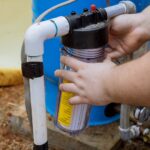Imagine sipping a refreshing glass of water straight from your refrigerator, only to find it tinged with an unpleasant taste or odor. Maintaining the purity and efficiency of your refrigerator’s water supply hinges on one crucial task: regularly replacing its water filter. This often-overlooked chore is key to ensuring your family enjoys clean and safe drinking water while keeping your appliance running smoothly.
- Understand why changing your refrigerator water filter is essential for clean water and efficient operation.
- Identify telltale signs such as taste and flow changes that signal it’s time for a replacement.
- Gather essential tools and materials to ensure a smooth filter replacement process.
- Follow a detailed, step-by-step guide to replace your water filter effortlessly.
- Learn best practices for maintaining your water filter, extending its life and performance.
By the end of this guide, you’ll be equipped with the knowledge to tackle water filter replacements confidently, ensuring your drinking water remains pristine and your refrigerator continues to operate at its best.
Understanding the Importance of Replacing Refrigerator Water Filters
Regularly replacing your refrigerator water filter is essential for maintaining the purity and safety of your drinking water. Over time, filters can become clogged with impurities, reducing their effectiveness in removing contaminants such as chlorine, lead, and other harmful substances. Without timely replacement, the risk of consuming polluted water increases, which can potentially affect your health.
Another key reason to change your water filter is to prevent the buildup of sediment and deposits within the filter. This accumulation can lead to reduced water flow and pressure, making it difficult for your refrigerator to dispense water efficiently. Consequently, the appliance’s overall performance may suffer, leading to increased energy consumption and potential damage.
To ensure the optimal functionality of your refrigerator and the continued delivery of clean and fresh water, it is recommended to follow the manufacturer’s guidelines on filter replacement frequency. Typically, every six months is ideal, but this can vary depending on usage and water quality.
Signs That It’s Time to Replace Your Water Filter
Recognizing the signs that indicate a need for water filter replacement can save you from consuming contaminated water and help maintain your refrigerator’s performance. One of the most noticeable indicators is a change in the taste of your water. If the water begins to taste different, it may be due to an expired filter that is no longer removing impurities effectively.
Another signal is an unusual odor emanating from your water or ice. This can occur when the filter becomes saturated with contaminants and is no longer able to neutralize unwanted smells. Similarly, a reduction in water flow rate is a common sign of a clogged filter, making it difficult for water to pass through efficiently.
Paying attention to these signs and acting promptly can help ensure that your refrigerator continues to provide safe and enjoyable water for you and your family. Regular monitoring and timely replacement will keep your appliance functioning at peak efficiency.
Tools and Materials Needed for Replacing Refrigerator Water Filters
Before diving into the refrigerator water filter replacement process, it’s important to gather all essential tools and materials. Having everything ready will ensure a smooth and hassle-free experience. Here are the key items you’ll need:
Screwdriver: Depending on your refrigerator model, you may need a screwdriver to remove the panel securing the filter.
Replacement Filter: Make sure to purchase the correct filter model for your refrigerator. Check your owner’s manual or the model number on the existing filter to ensure compatibility.
Gloves: Wearing gloves can protect your hands and provide a better grip when handling the filter, especially if it is wet or tightly secured.
Towel or Cloth: Keep a towel or cloth handy to wipe up any spills or drips that might occur during the filter replacement.
Equipping yourself with these tools and materials will not only make the filter replacement process more efficient but will also help maintain your appliance in top condition.
Step-by-Step Guide to Replacing Refrigerator Water Filters
Replacing your refrigerator’s water filter is a simple process when following the right steps. This guide will walk you through each phase of the replacement, from locating the filter to successful disposal:
Step 1: Locate the Filter
Begin by identifying where your refrigerator’s water filter is located. This could be in the grille at the base, inside the refrigerator compartment, or on the back wall. Refer to your refrigerator manual if unsure.
Step 2: Turn Off the Water Supply
Before removing the old filter, turn off the water supply to prevent leaks. This can usually be done by shutting off the valve behind the refrigerator.
Step 3: Remove the Old Filter
Twist or pull the old filter to release it from its housing. Be prepared to catch any water that might spill from the filter or housing unit.
Step 4: Install the New Filter
Once the old filter is out, insert the new filter into the housing, ensuring it is secured and aligned properly. Follow the directional arrows if applicable.
Step 5: Turn On the Water Supply
After securely installing the new filter, turn the water supply back on. Check for leaks to ensure everything has been reconnected properly.
Step 6: Flush the Filter
Run water through the new filter to flush out any carbon residue. Usually, several liters of water should pass through before use. This step is crucial for ensuring the highest water quality.
By carefully following these steps, you can maintain a high quality of water and ensure your refrigerator operates efficiently. Regularly replacing your water filter not only improves water taste but also prolongs the lifespan of your appliance.
Maintaining Your Refrigerator Water Filter for Longevity
Ensuring the longevity of your refrigerator water filter not only guarantees clean drinking water but also enhances the efficiency of your appliance. By following a few best practices, you can extend the lifespan of your water filter and enjoy optimal performance.
Regularly Check Filter Status: It’s vital to routinely check the status of your water filter. Many modern refrigerators come equipped with an indicator light that alerts you when it’s time to replace the filter. Pay attention to these indicators to prevent any impact on water quality.
Use a Compatible Filter Model: Always use the recommended filter type for your refrigerator. Compatible filters are designed to fit perfectly and function correctly, ensuring maximum filtration efficiency.
Insert Filter Properly: Incorrect installation can cause leakage and reduce filtration efficacy. Make sure to carefully follow the manufacturer’s instructions when inserting the filter. A proper fit helps in maintaining water pressure and flow, contributing to the filter’s longevity.
Flush the Filter After Installation: It’s a good practice to flush the newly installed water filter. Running several gallons of water through the filter helps remove any carbon particles and mineral deposits, resulting in better water flow and taste.
Store Filter Correctly: If you have extra filters on hand, store them in a cool and dry place. Proper storage helps in preserving the filter’s condition, ensuring it performs optimally when needed.
By implementing these practices, you can maintain your refrigerator water filter’s efficiency and lifespan, contributing not only to prolonged filter performance but also to the optimal functionality of your refrigerator.
Frequently Asked Questions About Replacing Refrigerator Water Filters
How often should I replace my refrigerator water filter?
It’s recommended to replace the filter every six months, but this can vary based on usage and water quality.
What happens if I don’t replace the refrigerator water filter?
Not replacing the filter can result in poor water quality, reduced flow rate, and potential clogs in your refrigerator’s water system.
Can I use any brand of water filter for my refrigerator?
It’s best to use the manufacturer’s recommended filter, but third-party filters can be compatible if they meet the specifications.
How do I know what type of filter I need?
Check your refrigerator’s manual or the existing filter for model numbers and specifications.
Are refrigerator water filters recyclable?
Many brands offer recycling programs, so check with the manufacturer for the best way to recycle your used filter.





